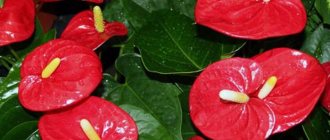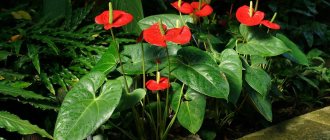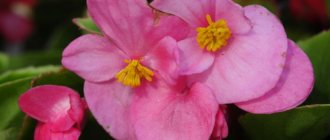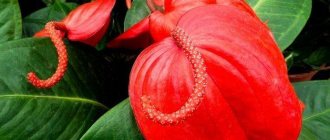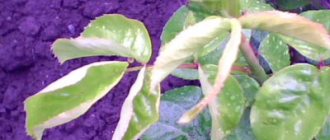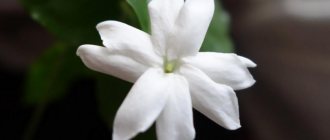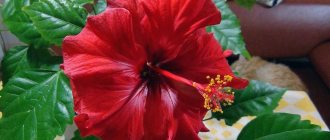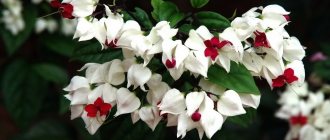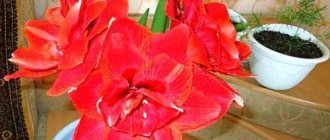Anthurium bloom
Anthurium is a typical inhabitant of the tropical forests of South America, grown here as a houseplant. Very often, due to the specific structure of the flower, it is called “male happiness.”
Anthurium leaves come in different shapes: dissected, oval, heart-shaped, matte or glossy, and grow up to 40 cm in length. But rarely does anyone buy it because of the beauty of the leaves. The main advantage is the flowers - an inflorescence-cob and a beautiful heart-shaped blanket, which can be red, pink, white, purple, burgundy, with a variety of shades.
Photos of flower varieties
Red anthurium most often appears on sale
Anthurium Otazu Brown with almost brown covers
Utah features purple cob and glossy textured blanket
Anthurium Black queen with black flowers and bright veins
Lady Love very beautiful pink anthurium
Fantasy Love - light pink cob and bedspread in pink, green and white shades, with bright veins
White champion absolutely white anthurium with a light green cob
White Heart anthurium impresses with its bright pink spadix and white heart-shaped spathe
Hawaiian Obake hybrids combine several shades in the bract
Anthurium varieties Tulip have a bract shape similar to a tulip
Princess Alexia Blue amazes with the purity of the color of the blue bracts
Each bud stays open for up to two months, then the color of the cover lightens and the flower dries up. With good and proper care, anthurium can produce flower stalks all year round, remaining decorative at all times. But most often, anthurium blooms from March to November.
The plant itself lives a long time, giving birth to children and growing up to 50 cm in width and 80 cm in height.
Air humidity plays an important role
Some types of anthurium (primarily Scherzer's anthurium) are less sensitive to dry air than others, but all anthuriums should be considered crops that require at least average indicators. If air humidity drops below 50%, it is better to immediately add spraying to your daily care or install trays with wet pebbles. The higher the temperature, the higher the air humidity should be.
The higher the temperature, the higher the air humidity for anthurium should be.
Necessary conditions for flowering
In order for your anthurium to regularly delight you with its flowering, you must comply with the following conditions.
Lighting is the most important parameter in care. Anthurium loves bright light, but without direct sunlight. It feels best on the eastern window and on the northern one, but with additional lighting. Light and day length are especially important during the period of bud formation - from November to February. If the plant vegetates during short days at this time, then flowering in the spring may not occur.
Temperature - anthurium does not like temperature changes, drafts and cold . In winter, it is better to keep it at 18–20 degrees, and always away from heating devices. To stimulate flowering, you can place it for 2 months in a room with a temperature of 15–16 degrees, but not lower, and at the same time very limit watering. In summer it tolerates normal room temperature, preferably no higher than 28 degrees.
Watering is regular, the top layer of soil should dry out . Follow the rule: the lower the temperature, the less watering. It is better to place the plant on a wide tray with wet expanded clay to increase humidity, and also periodically spray and wipe the leaves from dust, but at least once a week. Ideally, turn on a humidifier nearby.
Feeding in spring and summer . Anthurium can be fed 1–2 times a month with fertilizers for ornamental flowering plants, but diluted 2 times.
The soil in which “male happiness” grows is also important - it must be loose and breathable. To do this, you can buy ready-made soil for anthuriums or a universal soil for flowers with the obligatory addition of bark or soil for orchids.
If you are afraid of making the soil unsuitable, buy a special soil mixture for anthuriums
In January - February, the flower, previously kept in a cooler room, is transferred to a warm place with a temperature of 24-26 degrees. If there is a lack of light, be sure to supplement the lighting with phytolamps or ordinary fluorescent or cold-emitting LED lamps.
The peduncle can appear from almost any place where there is a growing point: from the center of the shoot or from the side.
The peduncle of an anthurium can emerge from any growth point
Here is an arrow with a painted end, the color of which depends on the color of the bedspread.
The peduncle grows slowly, the bud is closed
A strong, large plant produces several flower stalks at once. They grow slowly, the height of the peduncle can grow up to 50 cm.
Common mistakes when growing anthurium
Many anthurium lovers make the following mistakes when maintaining it:
- do not take into account the increased dryness of the air during the heating season or in the summer heat;
- no drainage;
- do not shade from direct rays of the sun, especially in summer when it is active;
- grown in dimly lit corridors and other poorly lit places;
- they forget to remove plants from the balcony in time during the onset of cold weather and do not monitor the decrease in temperature on the windowsill;
- keep the plant on a south window, where it is at risk of sunburn and overheating in summer;
- when ventilating, do not remove the flower from the draft;
- placed under the air conditioner;
- insufficient lighting in winter;
- using inappropriate soil (for example, for cacti), and sometimes they are simply planted in the soil from the garden;
- overgrown specimens are not replanted or renewed in a timely manner;
- water or spray with cold tap water;
- skip the rest period (although not all anthuriums need it);
- Plants are flooded all the time (the soil is too wet) or watering is skipped (the soil is dry).
Anthuriums can delight with their exquisite flowering almost all year round, if the necessary conditions are provided.
Did you know? Spectacular and bright anthurium flowers are often used in floral arrangements. After cutting, they can stand in a vase for a long time (up to 3–5 weeks). On sale you can find these flowers from Holland, which, after being cut, are placed in test tubes with nutrient liquid and stored at a temperature
+
8 °C.
Most often, flowering is absent due to lack of air humidity, poor lighting, non-compliance with temperature conditions, due to inappropriate container size and lack of useful elements.
“Male happiness” has blossomed. How does a plant need care?
If you become the owner of a flowering anthurium from a store, then your first desire is to transplant it into normal soil. But don't rush to do it right away. First of all, leave the plant for 1-2 weeks to get used to the new conditions. At this time, inspect the plant for hidden pests or diseases. If necessary, introduce quarantine for suspicious flowers, because it is easier to cure one newcomer than to process the entire collection later.
After 2 weeks from purchase, you can safely replant the plant. Almost all anthurium lovers advise replanting it by completely removing the old soil and washing the roots. If the bush is large enough and its age is more than 4 years, then at the same time you can divide the bush into several parts or carefully separate the children. Although it is better to do this before the anthurium blooms.
If you work carefully when transplanting a blooming anthurium, then the flowering will not be reflected in any way.
If you see rotten roots during transplantation, be sure to trim them to healthy tissue and sprinkle with crushed coal. A good stimulation and stress relief after such procedures will be soaking the roots for 20 minutes in the Kornevin solution and then spraying with Epin.
Soaking the roots for 20 minutes in a root solution will help survive replanting
If you got a very sick specimen and had to remove a lot of roots, then it is better to cut off the flower stalks and put them in water, and allow the plant to get stronger. In a vase with water, anthurium remains fresh for up to 2-3 weeks.
I wrote about how to properly transplant anthurium here.
For the first two months after transplanting into new soil, the anthurium is not fed, and then it is fertilized with a complex mineral fertilizer for flowering plants, where there will be a minimum of nitrogen. You should feed 1-2 times a month, diluting the recommended dose by 2 times. Overfeeding anthurium with nitrogen-containing fertilizers can lead to plant disease and the end of flowering.
Experienced anthurium growers recommend regular feeding of flowering plants with Orton Rost
The soil and method of transplantation are critical
Anthuriums should not be replanted carelessly, often changing pots and trying to correct any problems by changing the substrate. Actually, the plants cannot tolerate exposing the roots or completely replacing the soil and, in principle, it is better to simply reload them, keeping the earthen lump intact. Of course, with the exception of emergency transplantation to save the plant if it is affected by rot.
But you can replant anthuriums not only in spring, but also in summer, if desired (and necessary) by deepening them a little for thickening, growth of lateral shoots, and compensation for aging.
There is no need to disturb anthuriums every year: for this plant it is quite enough to simply change the top 4-5 cm of the substrate. And the transshipment itself should be carried out when the roots have completely mastered the substrate and appear in the drainage holes - on average, once every 2-3 years for adult anthuriums.
Anthuriums grow better in a special substrate - for anthuriums, aroids, bromeliads or orchids, pure bark, sphagnum, inert soils - than in ordinary substrates. They need a rough texture, resistance to compaction and a slightly acidic reaction. And a very high drainage layer.
Anthuriums have very few requirements for the pots themselves: the main thing is that the diameter exceeds the depth and there are drainage holes.
Flowering problems
“Male happiness” is a capricious flower. Even if flower stalks and buds appear on it, they may never open. Let's look at the main reasons for poor quality flowering.
Flowers are drying
If the flowers bloomed more than a month ago, then their drying is a biological process. New buds will be released to replace those that have bloomed, but if it is the young, and sometimes even unopened, buds that dry out, this indicates improper care.
Drying of flowers in the bud phase indicates too dry air
Drying of flowers and buds is primarily caused by insufficient humidity around the plant and lack of nutrition. If the anthurium’s soil dries out completely between waterings, and the room is very dry and hot, then it experiences stress, there is not enough moisture for the growing flowers, and they dry out. Subsequently, drying of the leaves and even death of the plant is possible.
Quite often, the flowers of anthuriums that stand on a south-facing, hot window dry out, even in a warm wind, and even more so in a draft.
When moving a flower from place to place, the flowers or leaves may also dry out.
Anthurium flowers turn green
Very often the color of anthurium flowers changes from bright to green. You shouldn’t be afraid of this - this is not a disease, just a natural cycle of the end of flowering. Usually green flowers are simply cut off. But if all the buds on the plant immediately begin to turn green, this may be a sign of a lack of nutrition when the anthurium completes its growing season and is preparing to rest.
Suitable lighting
One of the reasons for the popularity of anthurium among interior designers is its ability to grow in completely artificial light. But regardless of whether the light source is natural or not, the quality and intensity of lighting for this plant must be given special attention.
Anthuriums of all types grow best in soft, indirect light. They can be placed at some distance from southern windows, on eastern and western window sills; in summer they also do well on northern windows. Strong shading is unacceptable even for the most modest varieties and plants that have flowered.
When placed indoors rather than on a windowsill, if any signs of leaf shrinkage or color fading appear, it is better to rearrange the bushes in time.
Anthuriums of all types grow best in soft, indirect light.
Care after flowering
With good care, anthurium blooms for a long time, begins in March and ends with the arrival of autumn - in October - November. When the last flower dries, you need to trim it and place the pot in a bright but cool room without drafts. Such a place can be a bright windowsill, where the temperature is kept within +16...+18 degrees. Watch the cracks in the window carefully; even a small draft can destroy the plant.
A small draft from a crack in the window almost destroyed the anthurium
Place several thermometers near the pot to monitor the temperature, which can vary greatly on the windowsill.
In dried soil, anthurium will suffer less from the cold than in wet soil.
The plant should be watered extremely rarely during this period; there is no need to feed it. The ambient temperature should be increased at the end of January; the anthurium begins to wake up after winter and lay flower buds. It is very important that there is at least 12 hours of daylight.
Constant substrate moisture
Like the vast majority of indoor plants, anthurium does not like either dampness or drying out of the substrate. The soil should not be allowed to dry out completely, but overwatering is also dangerous. The more stable the soil moisture, the better. It is appropriate to carry out the next watering when the top few centimeters have dried out. In winter, it is better to dry the soil a little more, limiting watering by the amount of water.
Water quality is also very important. Anthurium does not tolerate salting; it needs soft water, slightly warmer than the temperature in the room.
Reasons for the lack of flowering of anthurium
Many gardeners complain about the lack of re-blooming in purchased anthurium. They replant, water and spray, but flower stalks do not appear.
The main reason for the lack of flowering is the unsuitable conditions created for the plant:
- anthurium is too young;
- too bright light or lack of lighting;
- unsuitable temperature: too hot or cold;
- a very large pot or improper soil;
- irregular or excessive watering;
- insufficient humidity in the room;
- too poor soil, lack or excess of fertilizers;
- roots are damaged during transplantation;
- drafts or changing the location of the pot;
- diseases, presence of pests;
- pollinated flowers, seed setting, presence of wilted flower stalks;
- wrong wintering.
What to do if the plant only produces leaves
When transplanting anthurium, gardeners often select the wrong pot, choosing one that is too large. In this case, the anthurium begins to grow in width, produce new leaves and children, but it will not bloom until its roots entwine the entire earthen lump. Therefore, take a pot 2–3 cm larger than the previous one.
To flower, anthurium needs a tight pot, take this into account when replanting
When feeding anthurium with fertilizers with a high nitrogen content, flower stalks also do not form, but the green mass grows.
Do not use fertilizers “For ornamental foliage plants” - your anthurium will only produce leaves
If the anthurium bloomed, but suddenly stopped, you may have increased watering or decreased air humidity.
Anthurium is frozen: it does not grow and does not bloom
Most anthuriums stop growing and blooming after improper or rough transplantation, when the roots of the plant were damaged.
If the plant is planted in unsuitable soil, the anthurium will not develop successfully either. The soil mixture must have coarse fibers, loose, breathable, with 2–3 cm of expanded clay at the bottom of the pot.
Favorable microclimate for the plant
A tropical plant needs special care; it loves warmth and light, and for normal flowering it also needs a special soil composition.
The flamingo flower feels comfortable when the air temperature warms up to at least 20 or 25 degrees in summer, and does not drop below 15 in winter.
Interesting! If you want to quickly see how the anthurium blooms, you should increase the air temperature to summer levels. It is worth considering that bud formation occurs only at a temperature of 16–19 degrees, so the temperature is kept at this level for some time.
This plant is native to the tropics, so the easiest way to make anthurium bloom is to increase air humidity. If there is excess moisture, rot appears on the roots, so you should look at the health of the plant. If there is no humidifier at home, then the pot is simply placed in a container with wet pebbles. The leaves of the flower are regularly sprayed or wiped with a sponge, but avoid getting moisture on the inflorescences.
Indoor plants of this type need light, but not direct, but only diffused. If the room where the pot is located is constantly dark, the anthurium will quickly wither.
Little tricks to stimulate flowering
So, we have found out the main reasons for the lack of flowering of anthurium. But what to do if all the conditions are met: the pot is cramped, the soil is correct, the light is bright, diffused, watering is regular, the air humidity is high, the winter temperature was low? There is only one answer - stimulating flowering by creating a stressful situation. And pouring the earthen clod with hot water, heated to 40–50 degrees, helps with this. It is important to use this technique only once.
Fertilizers for anthurium
In nature, anthurium grows on the roots of trees and even on branches, so it takes all its nutrition from moist air. Therefore, many gardeners also do not feed their anthuriums, but make up for the lack of nutrients with good soil and frequent replanting.
It is better to use liquid fertilizer diluted 2 times for flowering plants that contain less nitrogen than phosphorus and potassium. That is, if the package says to dilute a cap of fertilizer in a liter of water, then for anthurium you dilute the same cap in two liters of water.
To stimulate flowering, you can periodically spray with a solution of Epin, Bud or Ovary.
For long-term flowering, you can spray the inside with Bud solution, starting in February
And after transplanting, water with Kornevin or Zircon.
How to make Anthurium bloom?
Indoor anthuriums are potentially capable of blooming from February to November , that is, almost all year round, stopping only in the coldest and darkest winter months; in addition, their flowers are unusually durable when cut and remain unchanged for up to four weeks.
For such fabulous flowering, these plants need appropriate conditions, the observance of which requires considerable experience and knowledge.
The main problem is to find a balance of light, temperature, soil and humidity that will remind anthuriums of their native high-mountain tropical forests and they will probably agree to live and reproduce in your apartment.
Creating an appropriate microclimate includes providing lighting - bright but diffuse ; quite long throughout the year.
Temperature
Summer temperatures should be maintained at 20-25 degrees , winter temperatures in the range of 16-18 degrees .
The soil temperature should not be lower than the air temperature, so anthuriums are planted in plastic containers . These containers should not be deep - but not too wide, otherwise they will grow roots and children, not flowers.
Air and soil
Air saturated with water vapor should be fresh - but without drafts.
The soil is moist - but not wet.
Fertilizing is needed - but fertilizer solutions should not be too concentrated.
Compliance with all these “ifs” and “buts” is the main condition for constantly blooming “male happiness.”
And now, finally, your anthurium has blossomed - but it’s too early to calm down. After some time, the bright red blankets turn green, or the rich pink variety turns white, losing its color. This is a normal phenomenon, this is how these plants fade - and the outdated flowers need to be removed .
It also happens that you purchased a luxurious variety with numerous large flowers - but at home it somehow thinned out, crushed and reluctantly forms new inflorescences.
This situation may arise due to the fact that when commercially growing anthuriums in greenhouses, gibberellins, phytohormones that accelerate the growth and overall development of all parts of the plant, are used to improve their presentation.
Any suspicion of infection requires immediate action
In general, anthuriums are considered very resistant plants for a reason. But if you make mistakes in watering, or place the bushes in unfavorable conditions, they can easily be lost from anthracnose and rot (especially sulfur rot). Among the pests on anthuriums in dry air, aphids, spider mites, and scale insects are not uncommon.
If, during regular inspection, any suspicious spots and damage are noticed on the leaves and inflorescences, or there are growth disturbances, it is better to immediately isolate the bushes and begin treatment with systemic drugs, trying to correct unfavorable factors and change care as quickly as possible. With anthurium, it is better to carry out unnecessary preventive treatments than to miss the moment of the initial stage of infection.
Errors in watering
A stop in development can occur due to excessive watering, when the water in the pot is constantly in a swampy state. The roots will rot, which will disrupt the nutrition of the entire plant. The lack of flowering may also be due to a lack of moisture in the soil. As in other details, the flower loves the golden mean.
Moistening the soil should be done after the top layer has sufficiently dried. A large amount of water can be added at a time, but the procedure itself should be carried out infrequently.
Water requirements: soft, not cold, without calcium salts. When using tap water, it should be left in a glass container for 5 days before applying to the soil. If you use a filter, then settling is not required. The liquid should be acidified once every 7-14 days: 1-2 drops of lemon juice per liter.
What can I do to make Anthurium start growing?
Above, you read the reasons why Anthurium does not grow. To make it grow, you need to stop the one (or those) reasons that are suitable for your case.
If the Anthurium did not grow due to an incorrectly selected container or soil, then simply replant it taking into account the described tips.
If the reason was the wrong living environment, then do nothing with the plant itself, but simply change the conditions.
If you have not watered your plant correctly, I advise you to first check the root system for rot. If the roots are normal, then simply reconsider your watering system.
Be healthy!
